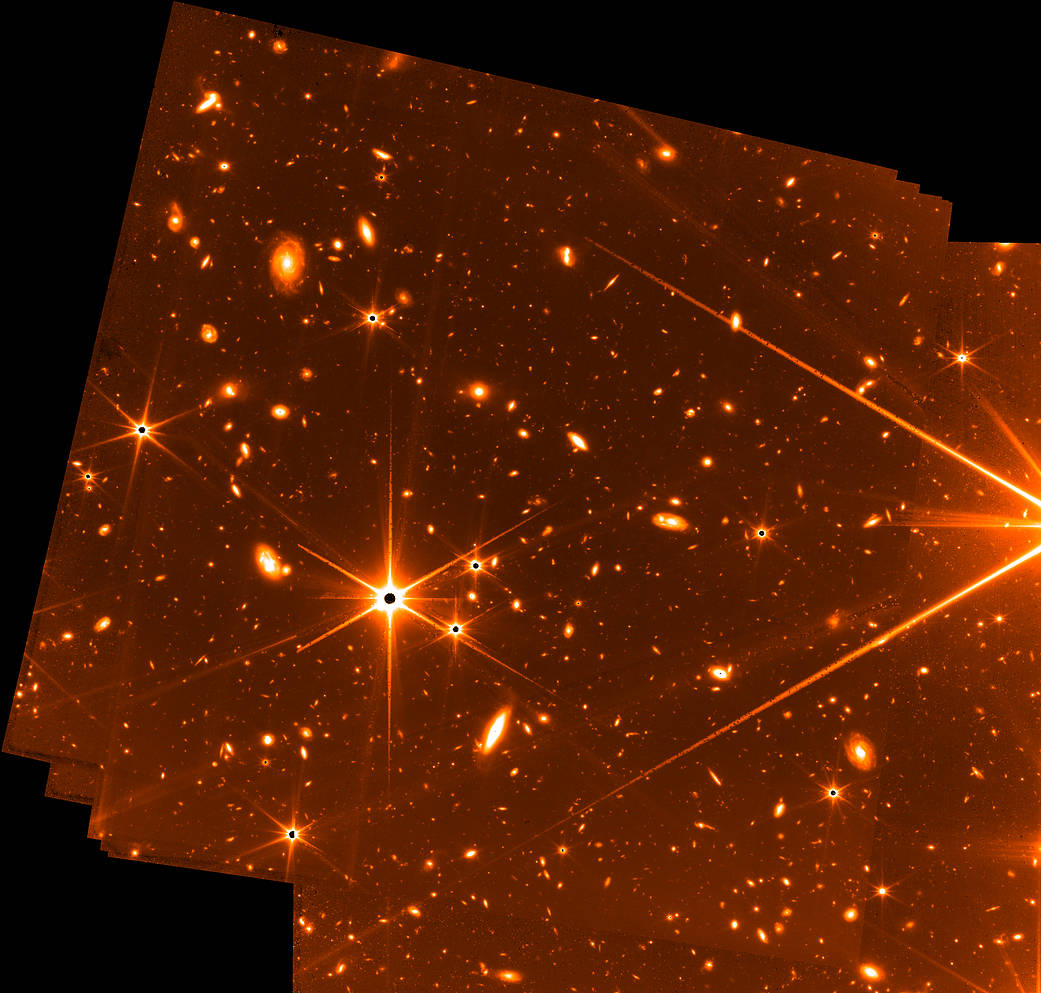We’re less than one week away from the July 12, 2022, release of the first science-quality images from NASA’s James Webb Space Telescope, but how does the observatory find and lock onto its targets? Webb’s Fine Guidance Sensor (FGS), developed by the Canadian Space Agency, was designed with this particular question in mind. Recently it captured a view of stars and galaxies that provides a tantalizing glimpse at what the telescope’s science instruments will reveal in the coming weeks, months, and years.
FGS has always been capable of capturing imagery, but its primary purpose is to enable accurate science measurements and imaging with precision pointing. When it does capture imagery, it is typically not kept: given the limited communications bandwidth between L2 and Earth, Webb only sends data from up to two science instruments at a time. But during the week-long stability test in May, it occurred to the team that they could keep the imagery that was being captured because there was available data transfer bandwidth.
The engineering test image – produced during a thermal stability test in mid-May – has some rough-around-the-edges qualities to it. It was not optimized to be a science observation, rather the data were taken to test how well the telescope could stay locked onto a target, but it does hint at the power of the telescope. It carries a few hallmarks of the views Webb has produced during its postlaunch preparations. Bright stars stand out with their six, long, sharply defined diffraction spikes – an effect due to Webb’s six-sided mirror segments. Beyond the stars – galaxies fill nearly the entire background.
The result – using 72 exposures over 32 hours – is among the deepest images of the universe ever taken, according to Webb scientists. When FGS’ aperture is open, it is not using color filters like the other science instruments – meaning it is impossible to study the age of the galaxies in this image with the rigor needed for scientific analysis. But: Even when capturing unplanned imagery during a test, FGS is capable of producing stunning views of the cosmos.
In this image, the FGS image was acquired in parallel with NIRCam imaging of the star HD147980 over a period of 8 days at the beginning of May. This image represents 32 hours of exposure time at several overlapping pointings of the Guider 2 channel. The observations were not optimized for detection of faint objects, but nevertheless the image captures extremely faint objects and is, for now, the deepest image of the infrared sky. The unfiltered wavelength response of the guider, from 0.6 to 5 micrometers, helps provide this extreme sensitivity. The image is mono-chromatic and is displayed in false color with white-yellow-orange-red representing the progression from brightest to dimmest. The bright star (at 9.3 magnitude) on the right hand edge is 2MASS 16235798+2826079. There are only a handful of stars in this image – distinguished by their diffraction spikes. The rest of the objects are thousands of faint galaxies, some in the nearby universe, but many, many more in the high redshift universe.
Learn More
James Webb Space Telescope blog
Join the Virtual Global Social for the Reveal of the James Webb Space Telescope’s First Images
Image Credit: NASA, CSA, and FGS team
距离2022年7月12日,NASA詹姆斯·韦伯太空望远镜发布第一张科学质量图像还有不到一周的时间,但天文台是如何找到并锁定其目标的呢?由加拿大航天局开发的韦伯精细制导传感器(FGS)的设计考虑了这一特殊问题。最近,它拍摄到了恒星和星系的景象,这让我们对望远镜的科学仪器在未来几周、几个月和几年内将揭示的情况有了一个诱人的一瞥。
FGS一直能够拍摄图像,但其主要目的是实现精确的科学测量和精确定位的成像。当它拍摄到图像时,通常不会保存:鉴于L2和地球之间的通信带宽有限,韦伯一次只能发送最多两个科学仪器的数据。但在5月份为期一周的稳定性测试中,研究团队突然想到,他们可以保留拍摄到的图像,因为有可用的数据传输带宽。
5月中旬热稳定性测试期间生成的工程测试图像边缘粗糙。这并不是为了科学观察而优化的,而是为了测试望远镜锁定目标的能力,但它确实暗示了望远镜的威力。它带有韦伯在发射后准备工作中产生的一些观点的特征。明亮的恒星以其六个长而清晰的衍射尖峰而引人注目——这是由于韦伯的六面镜段造成的。在恒星之外,星系几乎占据了整个背景。
韦伯的科学家表示,这张在32小时内曝光72次的照片是迄今为止拍摄的最深处的宇宙图像之一。当FGS的光圈打开时,它不像其他科学仪器那样使用滤色器,这意味着不可能用科学分析所需的严格程度来研究这张图像中星系的年龄。但是:即使在测试过程中拍摄到意外图像,FGS也能拍摄出令人惊叹的宇宙景象。
在这张图像中,FGS图像与NIRCam在5月初对HD147980星进行了为期8天的成像并行获得。这张图片显示了在导光板2通道的几个重叠点上的32小时曝光时间。观测结果并没有对微弱天体的探测进行优化,但尽管如此,这幅图像拍摄到了极其微弱的天体,而且是目前红外天空中最深处的图像。0.6到5微米的导向器未经过滤的波长响应有助于提供这种极高的灵敏度。该图像是单色的,以白、黄、橙、红的假颜色显示,代表从最亮到最暗的进程。右边的亮星(9.3等)是2MASS 16235798+2826079。这张图片中只有少数几颗恒星——通过它们的衍射峰来区分。其余的天体是数千个微弱的星系,有些在附近的宇宙中,但更多的是在高红移的宇宙中。
了解更多信息
图片来源:NASA、CSA和FGS团队







